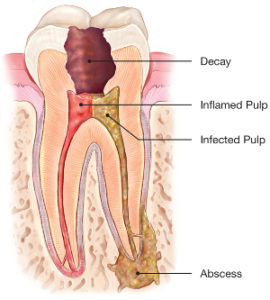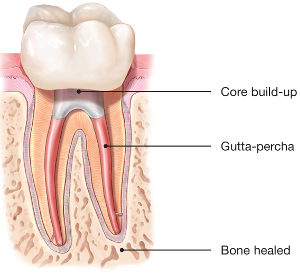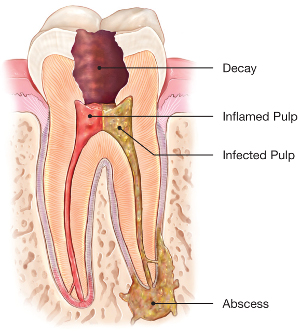What happens during root canal treatment? Learn more about this quick, comfortable procedure that can relieve your pain and save your natural tooth.
 There’s no need to be worried if your dentist or endodontist prescribes a root canal procedure to treat a damaged or diseased tooth. Millions of teeth are treated and saved this way each year, relieving pain and making teeth healthy again.
There’s no need to be worried if your dentist or endodontist prescribes a root canal procedure to treat a damaged or diseased tooth. Millions of teeth are treated and saved this way each year, relieving pain and making teeth healthy again.
Inside your tooth, beneath the white enamel and a hard layer called dentin, is a soft tissue called pulp. This tissue contains blood vessels, nerves and connective tissue, which help grow the root of your tooth during its development. A fully developed tooth can survive without the pulp because the tooth continues to be nourished by the tissues surrounding it.
Modern endodontic treatment is nothing like those old sayings! It’s very similar to a routine filling and can usually be completed in one or two appointments, depending upon the condition of your tooth and your personal circumstances. Getting a root canal is relatively painless and extremely effective. You’ll be back to smiling, biting and chewing with ease in no time.
Saving the natural tooth with root canal treatment has many advantages:
- Efficient chewing
- Normal biting force and sensation
- Natural appearance
- Protects other teeth from excessive wear or strain
Recommended Educational Videos on Root Canal Treatment
Root Canal Treatment Step by Step
There is no need to be anxious if you need a root canal and you’ll see why here. This informative video walks you through each step of the procedure and explains how endodontists – root canal specialists – can save your teeth.
Root Canal Safety
If you’re concerned about the safety of root canal treatments, watch this video and learn how endodontists perform millions of these procedures every year, safely, effectively and comfortably.
Visit the AAE YouTubeChannel for more patient education videos to learn more about root canals and other endodontic procedures.
How does endodontic treatment save the tooth?
 It’s necessary to have endodontic or root canal treatment when the inside of your tooth (the pulp) becomes inflamed or infected as a result of deep decay, repeated dental procedures, faulty crowns or a crack or chip in the tooth. Trauma to your tooth may also cause pulp damage even if the tooth has no visible chips or cracks. If pulp inflammation or infection is left untreated, in can cause pain or lead to an abscess.
It’s necessary to have endodontic or root canal treatment when the inside of your tooth (the pulp) becomes inflamed or infected as a result of deep decay, repeated dental procedures, faulty crowns or a crack or chip in the tooth. Trauma to your tooth may also cause pulp damage even if the tooth has no visible chips or cracks. If pulp inflammation or infection is left untreated, in can cause pain or lead to an abscess.
When you undergo a root canal or other endodontic treatment, the inflamed or infected pulp is removed and the inside of the tooth is carefully cleaned and disinfected, then filled and sealed with a rubber-like material called gutta-percha. Afterwards, the tooth is restored with a crown or filling for protection and will continue to function like any other tooth.
Endodontic treatment helps you maintain your natural smile, continue eating the foods you love and limits the need for ongoing dental work. With proper care, most teeth that have had root canal treatment can last a lifetime.
For more detailed information on root canals, click to visit our Root Canals Explained page that offers a step-by-step explanation of the procedure.
Original Article Here.
Reprinted with permission of the AAE. Copyright © 2017 American Association of Endodontists. All Rights Reserved.
